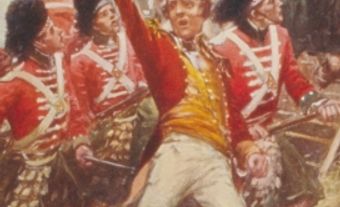Capture of Detroit, War of 1812
During the WAR OF 1812, the campaign in western Upper Canada began with the arrival of American Brigadier General William HULL, governor of the Michigan Territory, at Detroit with some 1600 men on 6-7 July 1812. Detroit itself was protected by a palisade and there was a fort on the landward side of the town. The installation's main weakness was that the fort could not easily fire on British ships on the DETROIT RIVER, or on British gun batteries on the opposite riverbank.On 12 July, Hull crossed the Detroit River unopposed and occupied Sandwich (Windsor). On 20 July, the general issued a bombastic proclamation to the Canadian militia to throw off their British shackles and embrace American liberty. Reconnaissance revealed that Amherstburg was weakly defended. But Hull refused to advance despite his militia officers' urging.
The Attacks on the American Supply Lines
Hull's legitimate concern was his vulnerable supply line. On 2 and 3 August 1812, TECUMSEH, Captain MUIR and Roundhead took a force of First Nations and about 100 redcoats across the Detroit River from Amherstburg, landing near the Wyandot village of Brownstown. The expedition added some 70 warriors to Tecumseh's force and was a direct threat to the supply line between Detroit and FORT ERIE. South of Brownstown, Tecumseh and 25 of his warriors ambushed a supply force, from which few survived.
On 8 August, General Hull sent a force of 600 men led by Lieutenant Colonel James Miller in another attempt to re-open his supply road. This force was also ambushed, at the Battle of Maguaga (about 20 km south of Detroit), but the Americans forced the British and Shawnee to retreat. Much to the frustration of his soldiers, on 11 August, a shaken General Hull ordered his forces in Sandwich to withdraw to Fort Detroit. He even suggested they should return to Ohio, but militia officers convinced him to stay in Detroit or risk losing his army to desertion. Hull's men had lost all confidence in him. Many believed he was a coward.
The double ambush near Brownstown was one of the most remarkable victories in First Nations history. Among the prizes was a cache of mail that provided an insight into the worried mind of the commander.
The Arrival of Isaac Brock
On 13 August Isaac BROCK arrived at FORT AMHERSTBURG (Malden) with 300 men. Against the advice of Henry PROCTER and all his officers except John MACDONELL and Robert Nichol, he decided to attack Fort Detroit. When Tecumseh heard this plan, he reportedly declared of Brock "This is a man!" Whether the story is true or not, the two men had great regard for one another and Tecumseh admired Brock's resolve.
Brock sent Hull a summons to surrender Detroit, warning him that once the battle commenced the large force of First Nations would be "beyond my control." The summons was rejected and the British battery at Sandwich opened fire on the American fort. Hull's 24-pounders replied.
That night of 15 August, some 530 First Nations warriors glided across the unguarded river in canoes and landed below Detroit. The British followed at daylight, with 300 regulars, 30 Royal Artillery, 400 militia and 70 Grand River Iroquois led by John NORTON, landing south of the fort, covered by the ships Queen Charlotte and General Hunter. Brock hoped to entice Hull into the open even though his force would be outnumbered.
The Surrender of Detroit
On 16 August, Brock marched up the road toward the fort as Tecumseh's men swept north through the forest. The popular story that Tecumseh marched his men three times through an opening in the forest to give the idea of a much larger force lacks real evidence. Nevertheless, at 10 am a white flag appeared over the walls of the fort. Brock's aides rode to the American line and returned with confirmation that Hull was prepared to surrender. The British column entered the fort as the Americans stacked their arms. Lieutenant Bullock led a detachment of the 41st as the band played "The British Grenadiers."
The American loss was considerable: some 2188 men, 39 guns, a large store of shot, flint, powder and supplies, and an unfinished ship, the Adams (soon renamed Detroit). The victory restored the whole Michigan territory to British control. The reaction of the American officials and public was disbelief and fury. Hull was court martialled and condemned to death, although the sentence was commuted. The hapless commander had simply convinced himself that he was being attacked by overwhelming forces and declared that he had saved his men and the 700 civilians (including his own daughter and granddaughter) from "the horrors of an Indian massacre."

 Share on Facebook
Share on Facebook Share on X
Share on X Share by Email
Share by Email Share on Google Classroom
Share on Google Classroom


